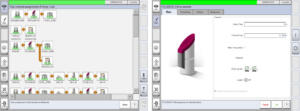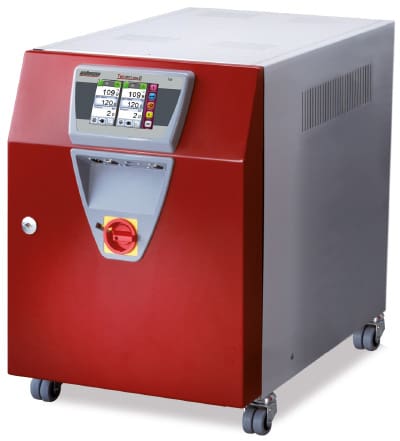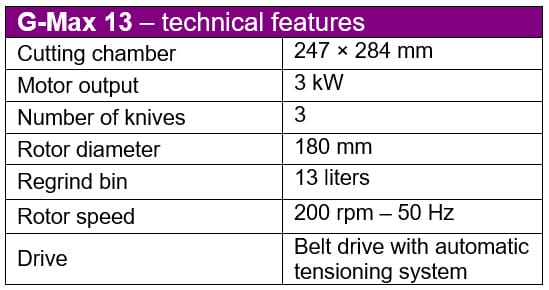
Wittmann Virtual Highlights 2020
Due to the postponement of FAKUMA 2020, Wittmann Battenfeld will be presenting its 2020 highlights on a digital ‘Virtual Fakuma’ portal. In this article, Wittmann gives the first overview of its latest developments in automation, recycling, material handling and temperature control.
Since the FAKUMA 2020 has been postponed to next year, due to the health risks caused by the SARS-CoV-2 virus, WITTMANN has now decided to present the exhibits originally planned for the Fakuma together with some other interesting applications by way of product videos, and to upload them on “Virtual Fakuma”. The presentation of the videos is intended to take place primarily in personal meetings with customers, web conferences are also planned as an alternative. To present the product highlights as vividly as possible to a wide audience, the product videos will also be made available on the company’s YouTube channel.
Revised WX153 with many new options
For Fakuma 2020, WITTMANN was presenting a completely redesigned WX153. This robot model is typically used for the automation of injection moulding machines with clamping forces ranging from 500 t to 1,300 t. The predecessor version was based on the W8 pro series of appliances, which has been on the market since 2013.

In the mechanical redesign of the WX153 robot, special attention was paid to maximum functionality and flexible application options. So the vertical axis is now available with strokes of up to 2,600 mm. The horizontal Z-axis can be supplied with a stroke length of up to 18,000 mm. With a stroke from 4,000 mm upwards, tandem solutions involving two independently moving robots can be implemented as well.
The control system of tandem robots also includes a joint R9 TeachBox, which is able to control up to 12 axes simultaneously. Here it is possible to choose just any combination of axes from individual robots or tandem appliances to create desired movement profiles as needed, which will subsequently run synchronously. Another new feature is the integrated compact controller housing, which contributes to even more efficient use of the carrier. The X-axis for demolding can be delivered with a stroke of 1,200 mm or 1,400 mm. In its standard configuration, the appliance offers 30 kg load capacity, which can be adjusted depending on the application. The WX153 robot comes with the WITTMANN R9 control system. It offers a great variety of different functions, such as a digital twin for test runs of the robot on the screen and for error analyses, as well as SmartRemoval to minimise mould opening times.
Video assistance in robots with R9 control
In live sports broadcasts, slow-motion replays of controversial or spectacular scenes have been common practice for a considerable time. Apart from the added entertainment value for spectators, such slow motion views also support correct decision-making by referees and can be used in training. This function is now also installed in WITTMANN robots with R9 control systems.

The task of the robot’s video assistant is performed by the digital twin, which is installed in every R9 control system as standard. The digital twin is displayed directly on the TeachBox and can replay preceding sequences at any desired speed. As the digital twin has access to the configuration of the physical robot on which it is installed, it is familiar with that robot’s equipment options and is able to visualise these appropriately.
As soon as the physical robot switches into the automatic operation mode, the twin records all changes in the positions of the individual axes, the entrance/exit points, the counters and all other values relevant for the operation of the appliance. All data are recorded with a precision of 4 ms and can be traced back into the past for up to 100 seconds. In this way, it is possible to access the record for any desired point in time. Another vital fact is that the teach-commands executed are saved here, too.
An example of a practical application could be the standstill of a robot for unknown reasons – with the subsequent option to retrieve a visualisation of the incident on the TeachBox for fault analysis. When the robot standstill occurs, the data recording is discontinued, and the preceding 100 seconds are now available for analysis. A time controller installed on the TeachBox makes it possible to define a point in time within the displayed sequence. This controller can be shifted in both directions as desired, in order to examine in detail and repeatedly critical changes of status which have occurred.
During the analysis, the physical robot could stay defective or out of function, since only the digital twin is moved on the TeachBox, and only its status changes are displayed.
The video assistant makes it much easier to detect causes of defects and supports the operator’s efforts to prevent a repetition of similar incidents. Consequently, it contributes to increasing the uptime of every R9 robot – and thus the efficiency in production.
G-Max 13 beside-the-press granulator
The G-Max 13 completes the existing G-Max granulator series from WITTMANN, which offers cutting chamber sizes ranging from 130 × 260 mm to 460 × 235 mm and engine outputs from 2.2 kW to 4 kW. The models from the G-Max series can be used for material throughputs of up to 50 kg/h on injection moulding machines with up to 500 t clamping force.
The G-Max 13 granulator is suitable for in-line recycling of soft to medium-hard sprue consisting of PP, PE, ABS or PU, and can be used on injection moulding machines with clamping forces of up to 230 tons.

The material screens of the G-Max 13 are available with screen perforation in different sizes: either 4 or 5 mm in diameter. This ensures suitability for varying materials and throughputs. The perforations in the screens have a conical shape, so that soft and sticky granulate can pass through more easily—a feature which ultimately contributes to minimising the accumulation of material deposits in the openings. The tiltable material hopper simplifies cleaning and servicing of the appliance enormously. For instance, a screen change can be carried out without tools, and the time required for servicing is reduced to a minimum.
The granulator has an open rotor with three knives. It is designed with openings between the knives and the rotary axis to ensure unhindered ventilation of the cutting chamber. Thanks to this type of design, this model is ideally suited for grinding materials which are sensitive to heat or parts not yet completely cooled. Exchanging knives is extremely easy and comfortable.
The new G-Max 13 can handle a material throughput of up to 35 kg/h (depending on the shape of the parts/sprues, screen size and quality of material), it operates with a low noise level and is extremely energy-efficient.
M8 network control for material handling systems
User-friendliness and functionality of control systems are a top priority for WITTMANN. With the revision of the current M7-IPC control system, the CAN-bus-based M8-IPC network control system has been introduced. It simplifies the administration of complex installations and shows a clear display of every appliance in modern design.

A new feature is a number of freely programmable modules – or “logical devices” – which support queries, counting functions, loops and much more, to enable logical switchover and connection of outlets. To give an example: as soon as one source of material runs out, the system switches over automatically to another source. These new possibilities to define logical operations offer users an easy way to program sequences perfectly geared to each individual process.
What is more, M8 comes with a “counting” functionality. Whenever a user wishes to have a certain action triggered following the execution of a fixed number of switch cycles, this is now very easy to implement.
Another new feature is coded regrind recycling. If the regrind coming from several machines is not all processed in the same way, the regrind from individual granulators can be transported unmixed into separate containers. RFID-coded materials handling devices ensure that materials are only transported if the material line is correctly connected to the granulator and to the matching container. In this way, mixing of different types of regrind is prevented.
Something often requested – and now also made possible: residual quantities of material left on the machine can be transported back to the material source. If the production is interrupted, there is a risk of dried material being left on the machine during the time of standstill, which then causes start-up problems when the production is resumed. Or it happens during a material change that left-over material on the machine is (mostly) emptied out and then disposed of. With the help of the M8-IPC control functions, such residual quantities can be “reclaimed” and re-used.
The operating status of the individual appliances catches the eye immediately, thanks to the different colour codes. In case of error signals, it is possible to have persons responsible notified by email.
Operators can choose between several different systems to perform the tasks assigned to them quickly and faultlessly.
For this purpose, several different views are available, showing the path followed by the material – through all stations right up to the consumer, that is, up to the machine and/or to the mould.
One view is assigned to the administration of users; it enables comprehensive administration of individual users or groups of users and the appliances allocated to them.
Another special view is available to visualise the vacuum participants. Here, the material loaders, valves, vacuum and filter stations of a given vacuum line (or all vacuum lines) are depicted clearly allocated in their context. In case of emergency shut-offs with the use of replacement pumps, the automatic changeover valves and all connections that have been changed are shown to the operator.
CARD – small dryers with a great effect
The new compressed air dryers from the CARD series have been an integral part of the WITTMANN product portfolio since April 1 of this year. The first few months have shown that, despite the great variety of different models and sizes, three types of appliances have become particularly popular. These are the sizes CARD 6G/FIT, CARD 10S and CARD 20S. On these appliances, the desired drying temperature can be set via a touch screen operating panel, and at the end of the pre-drying phase, a signal is issued to release an automatic production start-up. The material drying data can be exported via a USB port or via OPC UA.

With the integrated week timer, the use of the dryers can be ideally adapted to ongoing production planning, and they are ready to run immediately as soon as dried material is required. In the CARD S models, the compressed air consumption is very finely and precisely adjusted to the actual demand by an intelligent digital air volume control system.
If a material loader is used to fill the dryer, this ensures a continuous material supply, and the dryer recognises automatically when the drying temperature must be lowered.
If the interval between two conveying cycles exceeds a certain period of time, this is interpreted as “no material consumption”, and the dryer then starts the necessary actions to protect the material and to reduce energy consumption.
CARD dryers can be mounted directly onto the machine feed. In combination with a claw flange, the appliances can be pushed into a parking or emptying position.
If quick-change adapters are used on CARD dryers, this will save time when transferring the dryers from one machine to another.
TEMPRO plus D120 temperature controller
The response to the introduction of the single- and dual-circuit variants of the pressurised TEMPRO plus D100 appliance last year have far exceeded all expectations. In the feedback, the desire for a pressurised appliance of similar size with direct cooling was expressed again and again. To meet this demand, WITTMANN has now developed the new TEMPRO plus D120 temperature controller, also in a single- and a dual-circuit version.

Although its extensive standard equipment package is already impressive, the TEMPRO plus D120 will certainly leave no configuration wish whatsoever unfulfilled when combined with the available optional extras.
- TEMPRO plus D120 has a direct cooling capacity of 80 kW with a Δt of 75 °C as standard.
- The standard heating performance of 9 kW can be increased to 12 kW or 16 kW if a higher production temperature is required.
- The available choice consists exclusively of stainless steel pumps with wear-free magnetic couplings to accommodate maximum flow volumes ranging from 40 l/min to 90 l/min. A real speciality is the frequency-controlled pump model with a capacity of 1.1 kW / 50 l/min / 9bar. The advantages of having this pump model installed in a temperature controller are the differentiated options for parameter setting in terms of motor speed, pressure and flow volume. This enables users to decide for themselves by which parameter they wish to have their process regulated, and last not least with a view to energy-saving potential.
- In the era of digitally connected communication media, an interface via which numerous process parameters can be exchanged with all well-known brands of injection moulding machines is an absolute must. So the new EUROMAP 82.1 interface is available for the TEMPRO plus D120 as an option, and use of the OPC UA protocol as well. WITTMANN and WITTMANN BATTENFELD are pioneers in “one-stop shopping”, and as such also very well prepared for comprehensive digital communication of all components with each other in a production cell via the standard WITTMANN 4.0 interface.
The range includes many additional options to meet the requirements of every customer-specific application, with all conceivable equipment variants being available for both 1-circuit and 2-circuit models – of course with dimensions doubled for every 2-circuit version.

Wittmann Battenfeld
+44 (0)1933 275777
Website
Email






